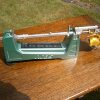CRM284
Member
- Joined
- Mar 10, 2020
- Messages
- 79
I'm a bit old school in the fact that I prefer a properly tuned beam scale over a digital scale. There's very little that can go wrong with a beam scale, where as a digital can have battery issues, ect..... Plus, top of the line, super accurate and consistent digital scales are outrageously expensive for my blood. I have better things to put that money towards. I've also seen where a properly tuned or accurized beam scale can literally measure single granules of powder. Usually these are done by Scott Parker or a guy in England. I'm not to a point where I need to measure single granules of powder, but it's nice to know that your scale is that sensitive, accurate, and consistent. I've made an extended pointer , added padded buffers, and in the near future I'm going to hook up a camera to make it easier to read as well.
So, have any of you guys accurized your 10-10, 5-10, or older rcbs, Lyman, and ohaus scales? If so, how did you go about doing it? How do you sharpen the blades and polish the bearing surfaces?
Thanks
Craig
So, have any of you guys accurized your 10-10, 5-10, or older rcbs, Lyman, and ohaus scales? If so, how did you go about doing it? How do you sharpen the blades and polish the bearing surfaces?
Thanks
Craig









